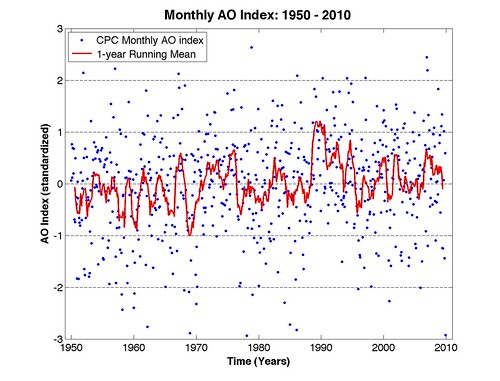The unusual pattern of atmospheric high and low pressure over and around the Arctic that has contributed to the recent snow and cold from Alabama to Washington, to East Anglia, England (and rain and warmth along the west coast of Greenland) is also an important influence on the shifting sheath of sea ice on the Arctic Ocean.
Several specialists studying Arctic sea ice told me that there’s a good chance that, if current conditions persist, the ice this spring could be in better shape than it has been over the last few years. In all of this, though, it’s important to step back from the lure of the moment, which quickly attracts bursts of attention from climate commentators when conditions favor one view or another, and examine long-term trends.
The polar pressure pattern, called the Arctic Oscillation (often abbreviated as A.O.), is deep in its negative phase at the moment — a depth not seen since the 1980s, according to Ignatius Rigor of the Polar Science Center at the University of Washington. Look at the lower right-hand corner of the graph above to see a blue dot signifying current conditions. But also be sure to note the red line indicating the running trend, which is slowly toward the positive side.
The fate of sea ice in the Arctic Ocean is determined by a complicated mix of factors, including the pressure changes, with the biggest loss of old thick ice resulting more from a great “flush” of floes than melting, Dr. Rigor and many other scientists tracking the region say. (Watch the animation below, provided by Dr. Rigor, to see the importance of motion in shaping ice conditions.)
Over all, Dr. Rigor says, the enduring trend is toward diminishing sea ice in summers. He and many other Arctic specialists say that human-caused climate change is undoubtedly playing a role, but one still largely hidden amid layers of complex natural influences and variability.
Florence Fetterer of the National Snow and Ice Data Center referred me to the results of a recent symposium on sea ice (pdf), described in the Bulletin of the American Meteorological Society:
Another natural atmospheric climate pattern that impacts sea-ice extent is the Arctic Oscillation (A.O.); the 2007 and 2008 winter A.O. index was more positive than in previous years (a positive phase of the A.O. is typically associated with warmer temperatures and export of ice from the Arctic Ocean), although not as strongly positive as in the early 1990s when sea-ice loss was less. It remains to be seen whether a future return to a consistently strongly negative A.O. (typically associated with cooler temperatures and sequestered ice in the Arctic) would be sufficient to reverse the trend of the recent warming and ice decline. Although it would seem that increasing temperatures and ice-ocean feedbacks leave the Arctic climate more susceptible
to natural atmospheric variability, it is unclear to what extent global climate change influences changes in the atmospheric circulation.



